Eric Kunsman, cradling a Hasselblad camera in his hands, stood at the intersection of Grape and Orange streets on Rochester's west side on a dreary Tuesday morning sizing up his latest subject.
To the untrained eye, there wasn't much to look at; just a closed corner store with wire mesh on its door. But Kunsman, a professional photographer and lecturer at the Rochester Institute of Technology, saw in the grim backdrop something special: A pair of pay phones.
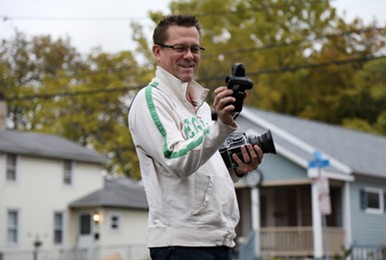
- PHOTO BY MAX SCHULTE
- Eric Kunsman
"What's that man doing?" a boy on a bicycle asked.
"Taking pictures of pay phones," I replied. "Have you ever used one?"
"Uh-uh," the boy said with a shake of his head as he pedaled away.
For nearly two years, Kunsman has been photographing Rochester and its suburbs one pay phone at a time.
"They're my babies," he said. "They're like my children in many ways. There's an experience in finding them."
Finding them has gotten harder. Once ubiquitous symbols of freedom, mobility, and salvation, pay phones have been rapidly vanishing since the advent of the mobile phone.
From their peak at 2.1 million units nationwide in 1999, pay phones today number fewer than 100,000, according to Federal Communications Commission. In Monroe County, there are fewer than 1,700, about a third of the number there were at the turn of the century.
They have not gone down quietly. The decline of the pay phone has been chronicled – some might say lamented – in news articles, documentaries, and on social media channels under hashtags like #payphoneography and the popular Instagram account @payphones, that pay homage to the outdated technology and its role in society.
Pay phones have rescued countless stranded motorists, delivered joyous news of births from maternity wards, and informed untold numbers of spouses that their better halves would be late for dinner.
"For decades, we handled all of your drug deals, love affairs, runaways, pimps, crime tips, cranks, heavy breathers, and emergencies," one of the last phone booths in Brooklyn growled in voiceover in the 2016 short documentary, "Dead Ringer." "You name it, we heard it all."
But Kunsman's pursuit is not a saccharine ode to pay phones. He doesn't romanticize them or wax nostalgic. His photography, he said, is about chronicling pay phones as social markers of race, class, and economics in greater Rochester.
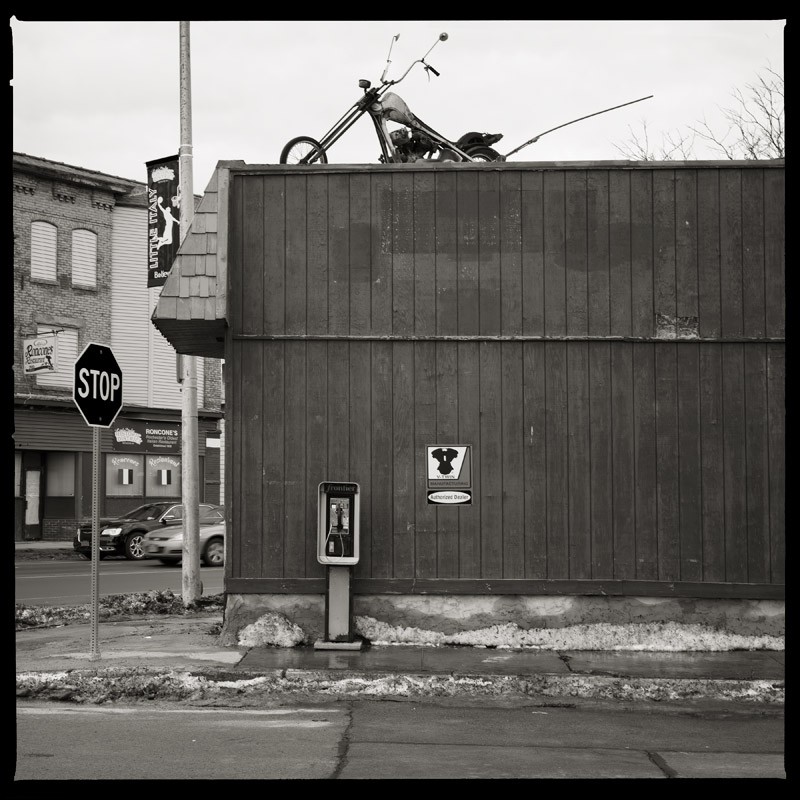
- Photo by Eric Kunsman
"This project is more about the environment these phones are in and trying to tell the stories of those environments," he said.
In his studio a few blocks away, he thumbed through a stack of hundreds of black-and-white images on oversized matte paper, recounting a story with each one.
There was the pair of pay phones outside the 490 Motel, the vandalized modern model standing in contrast to its pristine, older counterpart. There was the quaint phone booth in Pittsford. There was the pay phone that outlasted the vacant T-Mobile store in the background on State Street.
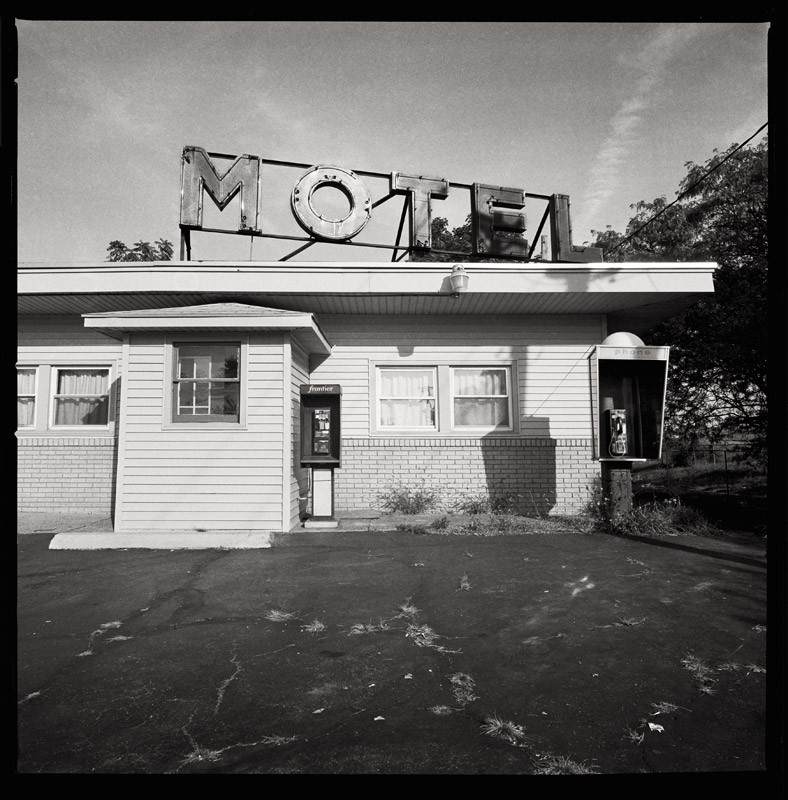
- Photo by Eric Kunsman
These are not snapshots. They are carefully considered portraits that evoke a relationship between a bygone technology and its surroundings. The photos, all black-and-white, are largely devoid of people, giving them a post-apocalyptic feel that is simultaneously beautiful and eerie and recalls the rise and fall of civilization.
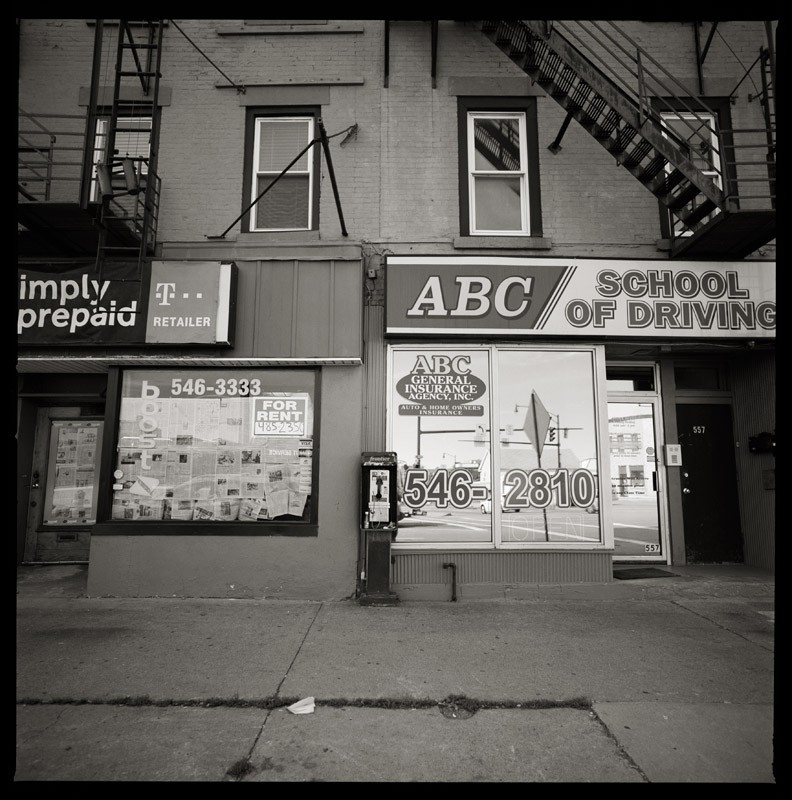
- Photo by Eric Kunsman
Some of his photos don't feature a pay phone at all, but rather a discolored wall where one had been mounted. In one such image he captured inside the Genesee Brewery, phone numbers for the union and take-out eateries were scrawled on the wall around the ghostly outline of what was a pay phone.
Two galleries, CEPA Gallery in Buffalo and Gallery 19 in Chicago, have already agreed to exhibit his work in 2021.
A WAR ZONE
Kunsman has photographed 476 pay phones to date. When he began the project, finding them required summoning an intuition for their presence – once acute in anyone who lived in the 20th century and was desperate to make a call – that went dormant years ago.
"We called it pay phone hunting," Kunsman, a 43-year-old married father of two who resides in Penfield, said. "My daughter, who is 4-and-a-half now, she has an eagle eye. We'd be driving and she'd shout, 'Payphone!'"
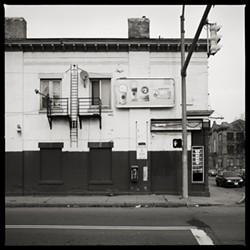
- Photo by Eric Kunsman
These days, he works off a list provided to him by Frontier Communications Corp., which operates most of the pay phones in the region.
The list pinpoints the locations of 1,455 pay phones in Monroe County, although the company estimates it has about 1,650.
Whatever the number, there will likely be fewer tomorrow than there are today. The number of pay phones have been reduced by more than half in the last five years, according to the company, and a spokesperson told CITY the company could not verify which phones on the list still existed or were in working order.
"We don't follow the pay phone business that closely anymore," the spokesperson, Bob Elek, said.
The muse for the project struck Kunsman shortly after he moved his studio in 2017 from the Neighborhood of the Arts to Walnut Street in JOSANA, a neighborhood that is slowing turning around after decades of decline.
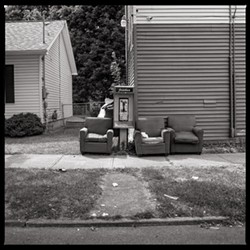
- Photo by Eric Kunsman
"When I moved here, my friends called this a war zone," Kunsman said, recalling them pointing to the abandoned buildings and vacant lots that still dot the neighborhood. "Some of them pointed out the number of pay phones."
The implication, of course, was that where there were pay phones, there was crime. That thinking came to the fore in the 1990s, when pay phone companies acknowledged their product was a tool for drug dealers, gamblers, and pimps, due to privacy laws that allowed callers to remain anonymous.
Some large cities began implementing site-specific restrictions on pay phones, such as prohibiting their installation outside public housing developments and liquor stores. Others went so far as to propose legislation – ultimately unsuccessfully – to eliminate pay phones.
But Kunsman saw a different correlation: Pay phones remained mostly in places where people needed them. That meant economically-distressed neighborhoods occupied primarily by people of color.
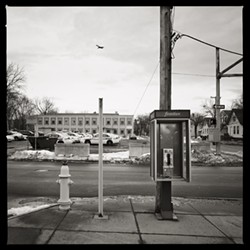
- Photo by Eric Kunsman
"People still rely on these," Kunsman said. "We think everyone has a cell phone, but really, it moves beyond certain economic classes."
As of the 2010 Census, there were nearly 3 million households in the country without access to either a landline or a cellphone, including at least 6,883 in the Rochester area.
Access to mobile phones among the poor increased under Lifeline, a federal program launched during the Reagan administration that provides basic telephone service to the neediest Americans for free or at deep discounts. The program was expanded to include wireless phones during the presidency of George W. Bush and was accelerated under President Barack Obama. The phones came to be known by the pejorative moniker "Obama phone," a shorthand among critics for the excesses of a welfare state.
But not everyone living in poverty got one.
Joan Hinman, a volunteer at the House of Mercy homeless shelter and soup kitchen on Ormond Street, said many people who use the organization's services today rely on the house phone to make and receive calls.
"It's not unusual for people to say they don't have a phone," Hinman said.
At World Wide News, a downtown convenience store on St. Paul Street, people still attempt to use the pay phone outside from time to time.
"It hasn't worked in maybe four, five months," said John Theodorou, a co-owner of the store. "A lot of people still ask about it. A lot of people still don't have their own phone."
FELICIFIC CALCULUS
In visiting the locations of pay phones, Kunsman suspected he recognized an example of something called felicific calculus – an algorithm formulated by the 18th century utilitarian philosopher Jeremy Bentham for working out the sum total of pleasure and pain produced by an act, and thus the total value of its consequences.
"Aware of the poverty in some areas of the city, (Frontier) chose to leave and maintain public pay phones in the areas where they are most needed," Kunsman wrote in his artist's statement for his project, which he named, "Felicific Calculus: Technology as a Social Marker of Race, Class, and Economics in Rochester, NY."
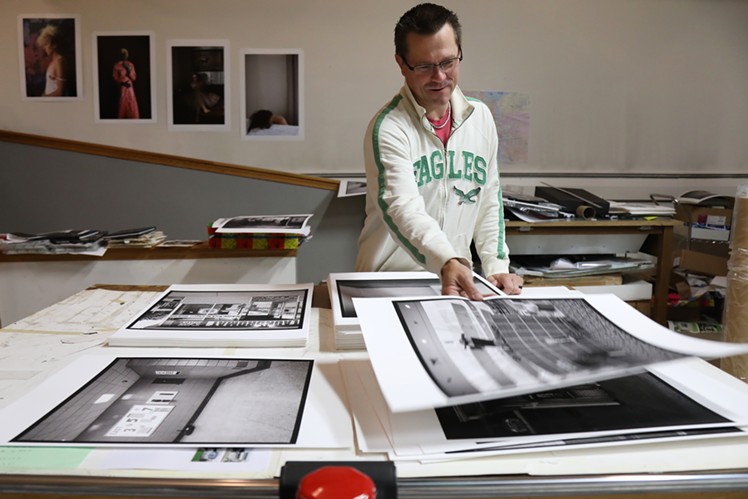
- Max Schulte
- Photographer Eric Kunsman sifts through a few of the hundreds of photos he has taken of Rochester's remaining pay phones. His work will be exhibited in 2021.
"This choice by Frontier is not the typical profit-driven decision usually seen in corporate America, but appears to be one based on actual community service," the statement read.
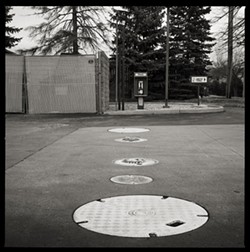
- Photo by Eric Kunsman
How altruistic Frontier is behaving in relation to its pay phones is a matter of opinion.
"It's a declining business and decisions made about it are pretty black and white," Elek, the company spokesperson, said of pay phones.
Financial analysts have called the company "over-leveraged" and its stock price of about $1 "over-priced," and have speculated it will file for bankruptcy protection in the near future.
Frontier's remaining pay phones on the streets of Rochester and elsewhere may be a function of the company not having the capacity, or interest, to tend to them.
"The number of pay phones in Monroe County and Rochester will continue to decrease as the general public now mostly uses near-universally available wireless phones," Elek said. "There are still approximately 1,650 pay phones available in the county, and as long as the remaining units are used enough to support the maintenance and operation costs, Frontier will be able to keep them in service."
COLLECTING STORIES
Kunsman hopes to complement his exhibit with a pay phone mounted to the gallery wall that, when the receiver is picked up, plays stories recorded by people who relied on pay phones in Rochester.
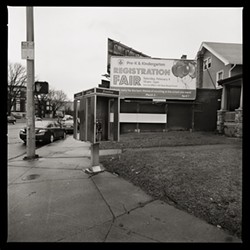
People like Joe Davila, who was panhandling outside World Wide News.
The 44-year-old Rochester resident explained that he has had mobile phones in the past, but either lost them, had them confiscated when he went to jail, or scrapped them when they ran out of pre-paid minutes.
Davila said he used a pay phone in Irondequoit recently to call his mother. "What else are you going to do when you got no phone?" he asked.
To collect stories like that, Kunsman plans to advertise on the working pay phones he photographs (he checks every phone for a dial tone and estimates a third of them have one). His strategy is to affix a postcard to them that will invite callers to participate in an audio interview about their use of the phone in exchange for $25.
"For me, it's about getting these stories out, because Rochester's not the only one," Kunsman said.
He recalled a recent conversation he had with two homeless men outside an abandoned strip mall while on a business trip to Tucson, Arizona. One of them used a wheelchair, he said.
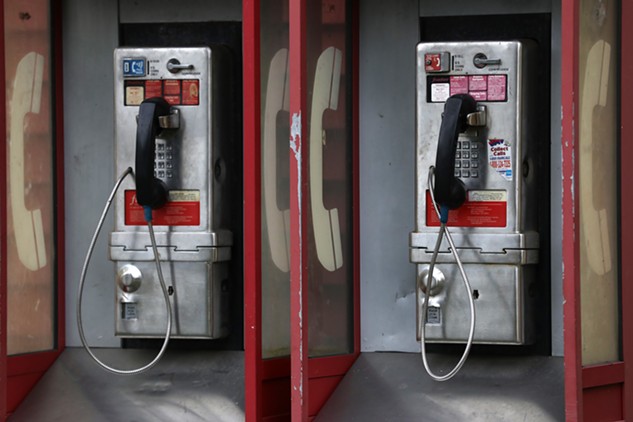
- Max Schulte
"There were two pay phones right there," he said. "And I asked them, 'Do you rely on these pay phones?' The answer was, 'They shut it off on us a three months ago, we now have to go six blocks down.' They knew the ones that worked.
"It's just about being aware that people are relying on them."
David Andreatta is CITY's editor. He can be reached at [email protected].
